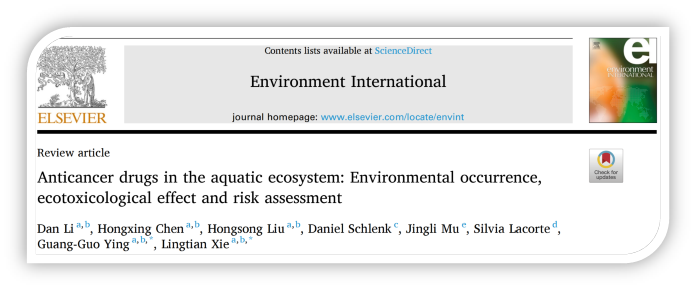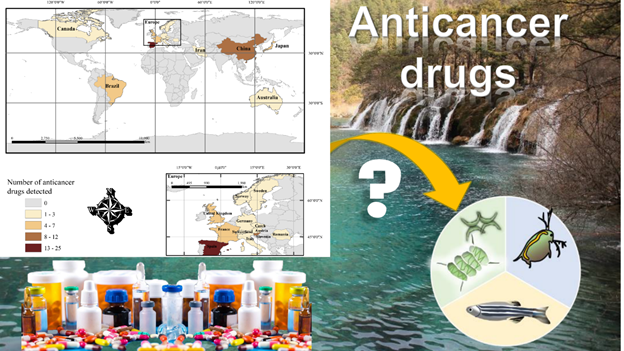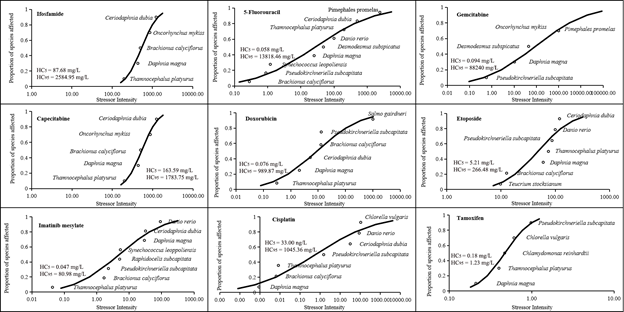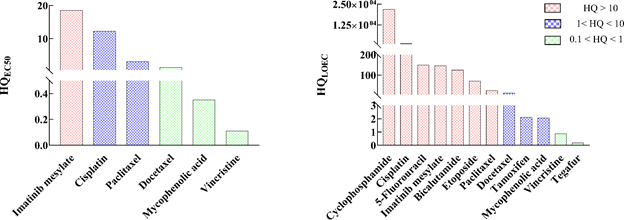Recently, Dr. Dan Li published a review entitled “Anticancer drugs in the aquatic ecosystem: Environmental occurrence, ecotoxicological effects and risk assessment” in the top journal – Environment International.

Graphic Abstract

Main Content
This review focuses on the global occurrence of major classes of 33 anticancer drugs in the freshwater ecosystems and their ecotoxicological effects at different biological levels. While the availability of data is fairly limited, concentrations of most anticancer drugs range from < 2 ng/L to 762 µg/L in receiving water. Their detection frequencies were 58%, 52% (78%) and 59% in hospital wastewater, wastewater treatment plant effluents (influents) and surface water, respectively. Predicted logKow values of vincristine, imatinib mesylate and tamoxifen are higher than 3 and have estimated half-lives >60 d in waters using quantitative structure–activity relationship models, indicating high potential for persistence and bioaccumulation. Based on a species sensitivity distribution evaluation of 9 compounds, crustaceans are most sensitive to anticancer drugs. The most hazardous compound is cisplatin which has a hazard concentration at the 5th percentile. For Daphnia magna, the acute toxicities of major classes of anticancer drugs are ranked as platinum complexes > endocrine therapy agents > antibiotics > antimetabolite agents > alkylating agents. Using hazard quotient analysis based primarily on the lowest observed effect concentrations (LOECs), cyclophosphamide, cisplatin, 5-fluorouracil, imatinib mesylate, bicalutamide, etoposide and paclitaxel have the highest hazard for aquatic organisms.
Introduction
Anticancer drugs are a group of therapeutic agents used to enhance cell death in targeted cell types of neoplasia. Because of frequent use and eventual discharge, they have been often detected in wastewater from pharmaceutical factories and hospitals, domestic wastewater, and surface waters. The occurrence of these drugs in aquatic ecosystems and their effects on aquatic organisms have been poorly characterized. This review focuses on the global occurrence of major classes of anticancer drugs in water and sediments of freshwater ecosystems and their ecotoxicological effects at different biological levels. In addition, environmental risk assessments of anticancer drugs were evaluated with QSAR, SSD and HQ, and uncertainties and future research directions on anticancer drugs are provided for management of anticancer drugs in the aquatic systems.
Environmental risk assessment

In this study, SSDs of 9 anticancer drugs had acute toxicity endpoints within>5 aquatic species. The most sensitive aquatic species to IF, CDDP and TMX were crustaceans (D. magna). The HC5 values were 87.68 mg/L, 33 ng/L and 181 µg/L, respectively. Similarly, the most sensitive species to CAP, DOX and IM toxicity was the crustacean (Thamnocephalus platyurus), with HC5 values of 163.59 mg/L, 76 µg/L and 47 µg/L, respectively. The most sensitive species to ETO was the crustacean (Artemia sp.), with an HC5 of 5.21 mg/L. The most sensitive species to 5-FU and GEM was the algae (Pseudokirchneriella subcapitata). HC5 were 94 µg/L and 58 µg/L, respectively. Overall, crustaceans were more sensitive to the acute toxicity of most of anticancer. Only CDDP shown a high hazard at the 5th percentile on the aquatic organisms based on the measured environmental concentration.

As indicated with the highest measured concentration in the aquatic environment, HQEC50, HQLOEC and HQHC5 of anticancer drugs are calculated. HQEC50 values for VINC (0.11), CDDP (0.12) and MYA (0.35) were indicative of a low acute hazard (0.1 < HQEC50 < 1). Acute effects of PAC (3.03) and DOC (1.35) were of moderate hazard in the aquatic environment, while IM (10) indicated high hazard for acute effects. For chronic effects, TEG and VINC presented low hazard, and CDDP (1.12), MYA (2.06) and TMX (2.10) represented a moderate potential hazard for aquatic organisms. In addition, HQLOEC values of CP (22000), CDDP (1150), 5-FU (150), IM (146.45), BLT (125), ETO (71.00), PAC (24.36) and DOC (11.15) were above 10, indicating that these anticancer drugs may have high hazard with respect to chronic exposure of aquatic organisms and should be preferentially taken into account.
Perspectives
Given that cancer incidence has increased over the last years with urbanization development, environmental pollution and unhealthy lifestyle and is foreseen to increase, it is anticipated that the consumption of cytostatic drugs will equally increase. Thus, their control in the environment is of utmost importance. Further research is needed to identify appropriate chronic endpoints for risk assessment thresholds as well as to better understand the mechanisms of action and the potential multigenerational toxicity, and trophic transfer in ecosystems.
First Author: Dan Li;
Corresponding Author: Prof. Guang-Guo Ying and Lingtian Xie
Reference: Dan Li, Hongxing Chen, Hongsong Liu, Daniel Schlenk, Jingli Mu, Silvia Lacorte, Guang-Guo Ying*, Lingtian Xie*, 2021. Anticancer drugs in the aquatic ecosystem: Environmental occurrence, ecotoxicological effect and risk assessment. Environment International, 153, 2021, 106543.
Link for full-text: https://doi.org/10.1016/j.envint.2021.106543